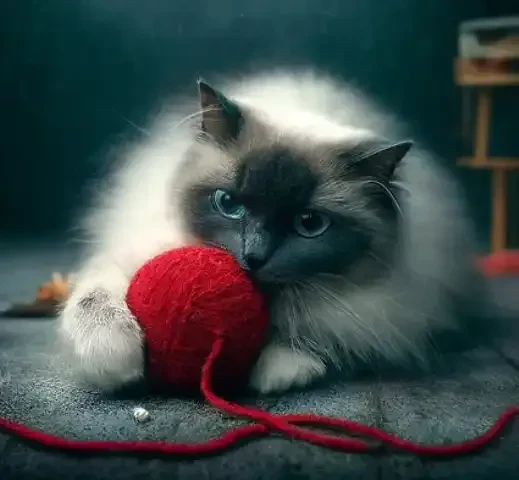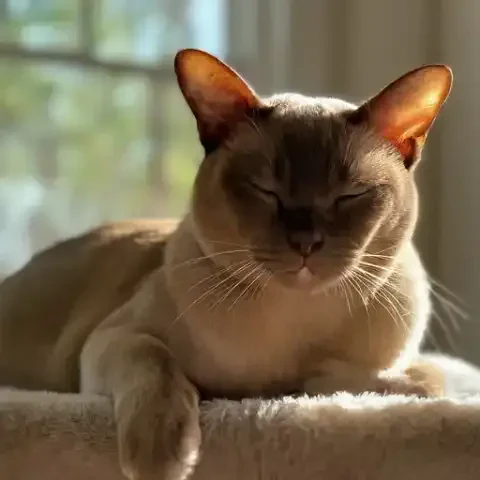Let's be honest, cats have a reputation. Aloof, independent, enigmatic, perhaps even a little… dense? We joke about them being fluffy furniture, more interested in sunbeams than in engaging with the complex human world around them. Dogs, with their wagging tails and eager-to-please personalities, get all the accolades for being "smart," for being our loyal, intelligent companions. But what if that's only half the story? What if, beneath that carefully cultivated air of feline detachment, lies a subtle genius, a quiet intelligence that we, in our human-centric view of the world, have been consistently, and perhaps unfairly, underestimating? Is it possible that we've been so busy focusing on the overt, tail-wagging enthusiasm of dogs that we've completely missed the nuanced brilliance of our feline housemates? It's time to challenge the stereotype, to push past the simplistic image of the cat as a beautiful but somewhat vacant creature. Because the truth is, cats are intelligent. They are demonstrably, undeniably clever, resourceful, and cognitively far more capable than many people readily acknowledge. It's just that their intelligence operates on a different frequency, expressed in ways that are often more subtle, more internally driven, and less overtly aimed at pleasing humans. Feline intelligence isn’t about performing tricks on command or fetching the morning paper; it's about problem-solving on their own terms, keen observation of their surroundings, and communicating their needs and desires in ways that are uniquely, and often brilliantly, effective. This article is an exploration, a deep dive into the surprisingly sharp minds of our feline companions. We will delve into numerous instances where cats have displayed truly impressive cognitive abilities, providing compelling evidence that they are, indeed, far smarter than we often give them credit for. We're about to embark on a journey into the hidden intellectual landscape of the feline world, showcasing the times when cats have demonstrably "outsmarted" not just our assumptions, but sometimes, even us. We’ll uncover their cunning problem-solving prowess, their surprisingly sophisticated methods of communication, their remarkable ability to learn routines and remember details, and even touch upon their often-overlooked emotional intelligence. Prepare to have your preconceived notions challenged, your understanding of feline cognition expanded, and to emerge with a newfound respect for the quiet, often underestimated, genius of the cat.
Let's begin by dismantling the myth of the feline airhead and stepping into the realm where cats truly shine: problem-solving. These aren't creatures content to simply accept the world as it is presented to them. Cats are, at heart, inquisitive explorers, and when faced with an obstacle, they are remarkably adept at figuring out how to overcome it, often with a level of ingenuity that can leave their human companions both impressed and slightly bewildered. Consider the humble puzzle feeder. Designed to challenge even the most intellectually stimulated pets, these devices require animals to manipulate levers, slide panels, or navigate complex mechanisms to access the tasty treats hidden within. Many dog owners readily embrace puzzle feeders, seeing them as a valuable enrichment tool. But what about cats? Are they too aloof, too uninterested, or simply not bright enough to engage with such contraptions? The answer, resoundingly, is no. In fact, many cat owners are consistently surprised by just how quickly and efficiently their feline companions master these seemingly complex puzzles. Anecdotes abound of cats, initially presented with a puzzle feeder for the first time, cautiously sniffing it, perhaps nudging it with a hesitant paw, and then, within a surprisingly short timeframe, systematically working out the solution. They’ll observe the moving parts, experiment with different approaches, and with a methodical, almost scientific, determination, unlock the secrets to accessing the reward. It's not brute force; it’s often a patient, deliberate process of trial and error, a testament to their cognitive flexibility and persistence. And for those of us who might have initially doubted their problem-solving abilities, witnessing a cat expertly dismantle a puzzle feeder designed to “enrich” their lives, it's a humbling, and slightly embarrassing, reminder to never underestimate the feline intellect.
Then there’s the classic example of the door and cabinet opener – the feline Houdini who views locked doors and securely fastened cabinets not as barriers, but as mere puzzles waiting to be solved. Stories circulate through the cat owner grapevine of cats who have mastered the seemingly impossible task of opening doors, cabinets, and even drawers, often employing methods that are both ingenious and slightly alarming in their effectiveness. They learn to manipulate door handles, understanding the lever action required to unlatch a door. They figure out how to nudge cabinet doors just so, exploiting a slightly loose hinge or a poorly aligned latch. Some even become adept at sliding doors, recognizing the horizontal movement needed to gain entry to forbidden territories. Consider the observational skills required to learn these complex mechanical tasks. Cats aren't simply stumbling upon these solutions by accident. They are watching, observing, and analyzing the mechanisms involved. They are noting the movements of human hands, the sounds of latches clicking, and the visual cues that indicate a door or cabinet is opening or closing. And then, with feline precision and determination, they translate that observational learning into action, replicating the necessary movements to achieve their desired outcome – often access to a forbidden room, a tempting stash of toys, or, most likely, a hidden cache of food. And let's not forget the truly humorous instances of cats gaining access to forbidden areas through their door-opening prowess. The pantry raided in the dead of night. The treat cupboard mysteriously ajar. The sock drawer inexplicably emptied onto the living room floor. These are not random acts of chaos; these are the calculated, cunning victories of feline intelligence, proving, time and time again, that when a cat sets its mind to something, particularly something involving access to resources, very little can stand in their way.
The allure of food, of course, often serves as a powerful motivator for feline problem-solving, leading to some truly remarkable displays of strategic thinking. Enter the “treat thief” strategist, the feline mastermind who devises elaborate, almost theatrical, plans to liberate treats or food from seemingly inaccessible locations. We’ve all attempted to “cat-proof” our homes, placing tempting snacks on high shelves, in tightly sealed containers, or tucked away in what we believe to be impenetrable locations. And yet, time and time again, cats manage to circumvent our carefully laid plans, demonstrating a level of ingenuity and determination that borders on the conspiratorial. Examples abound of cats utilizing furniture as tools, strategically positioning chairs or boxes to create makeshift climbing aids to reach elevated treats. They form elaborate, multi-stage plans, involving climbing, jumping, and precarious balancing acts to access their desired prize. In multi-cat households, this treat thievery can even become a team effort, a display of collaborative problem-solving where cats work together, employing different skills and strategies, to outwit their human providers and gain access to the forbidden culinary treasure. It's a testament to their planning skills, their spatial reasoning, and their ability to anticipate human behavior and exploit vulnerabilities in our supposedly foolproof storage methods. And for the human owners left scratching their heads, wondering how on earth that treat bag ended up shredded on the floor, there's often a grudging admiration mixed with the exasperation. We may be the ones who purchased the treats and attempted to hide them away, but it's our cats, with their clever strategies and unwavering determination, who ultimately emerge victorious, proving, in the most delicious way possible, that they are consistently, hilariously, and undeniably smarter than we often give them credit for.
Beyond specific problem-solving scenarios, cats demonstrate their intelligence in the way they navigate their environments, both indoors and out. Within the confines of our homes, they possess an almost uncanny ability to memorize layouts, remember routes, and identify hidden pathways. They seem to have a mental map of the entire house, effortlessly navigating from room to room, even in low light conditions, remembering furniture placement, and locating those hidden shortcuts that only they seem to know exist. Outdoors, if given the opportunity to explore, their navigational skills are even more impressive. They establish territories, learn complex routes, and often demonstrate a remarkable homing ability, finding their way back home even over long distances and unfamiliar terrain. This spatial intelligence, this ability to create and utilize mental maps of their surroundings, is a testament to their cognitive prowess, proving that their understanding of the world extends far beyond simply napping in sunbeams and batting at dangling toys.
But feline intelligence isn't solely confined to problem-solving and spatial navigation. They are also masters of communication, experts in conveying their needs, desires, and even subtle emotions, to those who are willing to truly listen – and decipher the often-misunderstood meow. It’s a common misconception that a cat’s meow is simply a generic sound, a random vocalization devoid of specific meaning. But the reality is far more nuanced and fascinating. Cat meows are not random; they are communicative signals, specifically tailored for interaction with humans. While cats may communicate with each other primarily through scent, body language, and the occasional hiss or growl, the meow is largely reserved for us, their human companions. And it's not a monolithic sound. Cats employ a wide range of meows, each subtly distinct in tone, pitch, and duration, to convey a variety of messages. There's the demanding, high-pitched meow that clearly signals a desire for food. The softer, more melodic meow that serves as a friendly greeting. The insistent, pleading meow that demands attention or playtime. And even the low-pitched, complaining meow that expresses dissatisfaction or displeasure. Cats are incredibly adept at adapting their meows to be effective communication tools with their specific owners. They learn what types of meows elicit the desired responses, refining their vocalizations over time to become increasingly efficient at getting their point across. Research into cat vocalizations has revealed a surprising level of complexity, suggesting that cats are capable of subtle vocal manipulation to influence human behavior. It’s not just “meow”; it’s a finely tuned, personalized language designed to bridge the communication gap between species.
Beyond vocalizations, cats are also masters of body language, communicating a vast array of emotions and intentions through subtle shifts in posture, ear position, tail movements, and even blink rate. Tail signals, far from being simple "happy wags," convey a complex spectrum of feline emotions. A high, upright tail often indicates happiness and confidence. A twitching tail can signal agitation or excitement. A tucked tail suggests fear or insecurity. Ear positions provide further insight into their emotional state. Ears forward indicate alertness and interest. Ears flattened back signal fear or aggression. Eye blinks, often overlooked by humans, are a surprisingly significant form of feline communication. The slow blink, in particular, is often interpreted as a sign of affection, a feline equivalent of a gentle, loving gaze. Rubbing and head bunting, those endearing feline behaviors, are not just random acts of affection; they are sophisticated forms of communication. Rubbing against your legs is a way of marking territory, claiming you as part of their domain, and simultaneously engaging in social bonding. Head bunting, gently nudging their head against you, is another sign of affection and trust, a way of exchanging scents and reinforcing their social connection with you. The key to understanding feline communication is to "listen" not just with our ears, but with our eyes. By paying close attention to their subtle body language cues, their nuanced vocalizations, and the context of their behavior, we can unlock a richer understanding of their inner world and appreciate the sophisticated communication strategies they employ.
And for those who still cling to the myth of the untrainable cat, prepare to be surprised. While cats may not be as overtly eager to please as dogs, they are certainly capable of learning human cues and commands, often with impressive speed and precision, when properly motivated. Cats can be trained. They can learn to respond to their names, come when called, sit, stay, fetch (sometimes!), use the toilet, and even perform more complex tricks. The key, of course, is understanding feline motivation and employing effective training techniques. Positive reinforcement, using rewards like treats, praise, or playtime to reinforce desired behaviors, is the most successful approach for training cats. Punishment-based methods are not only ineffective but can damage the bond between cat and owner and create fear and anxiety. Showcasing trained cats, whether through anecdotes, videos, or personal experience, serves as a powerful debunking of the "untrainable cat" myth. Cats can learn, they can adapt, and they can respond to human direction, proving yet again that their cognitive abilities are far more extensive than we often assume. Perhaps the most brilliant example of feline communication prowess is not just their ability to understand us, but their uncanny ability to "train" us to meet their every whim and desire. Cats are masters of operant conditioning, subtly and expertly shaping human behavior through learned associations. They quickly learn that certain meows, certain actions, certain strategically deployed behaviors, will elicit predictable and desired responses from their human companions. A plaintive meow near the food bowl reliably results in a refill of kibble. A gentle head-butt against your leg in the morning leads to a prompt breakfast. A strategically placed toy near your feet in the evening signals playtime. Cats are, in essence, “programming” their humans, creating a complex system of learned associations where their behaviors directly influence our actions. It’s a subtle, often humorous, form of manipulation, but it speaks volumes about their cognitive abilities. They are not just reacting to the world; they are actively shaping it, subtly orchestrating human behavior to ensure their needs are met, their desires are fulfilled, and their lives are, in every possible way, perfectly catered to.
Beyond immediate problem-solving and communication, cats also exhibit a remarkable capacity for remembering routines and demonstrating impressive memory skills, often far exceeding what we might expect. They are creatures of habit, deeply attuned to the rhythms of their daily lives, and their ability to anticipate and predict routines is a testament to their cognitive mapping of time and events. Cats possess an almost uncanny ability to predict daily routines, learning and anticipating the predictable patterns of their human households with astonishing accuracy. They know feeding times with almost clockwork precision, often appearing in the kitchen, patiently waiting, precisely at the moment their food is typically served. They anticipate their owner’s wake-up routines, appearing at the bedside just as the alarm is set to go off, ready for morning cuddles or, more likely, breakfast. They learn departure and arrival times, often waiting patiently by the door in anticipation of their owner’s return home from work or errands. It’s a demonstration of a strong internal “clock,” a remarkable ability to track time and associate specific events with predictable points in the daily schedule. Their lives are structured around routine, and their ability to learn and anticipate these patterns speaks to a sophisticated level of cognitive organization.
And their memory extends beyond just routines. Cats are memory marvels, capable of remembering locations, objects, and even social interactions over surprisingly long periods. They remember where toys are kept, often leading their owners directly to a specific drawer or container when playtime is desired. They remember the locations of favorite napping spots, food stashes, and scratching posts, navigating their environment with a spatial memory that is both efficient and impressive. Even after moving to a new home, cats often retain a memory of their previous residence, sometimes attempting to return to familiar territories, demonstrating a remarkable spatial recall. Anecdotes abound of cats remembering people or other animals after surprisingly long separations, greeting familiar faces with clear signs of recognition and affection, even after months or years apart. Cats possess different types of memory, including spatial memory (remembering locations), object memory (remembering where things are), and social memory (remembering interactions and relationships). All of these contribute to their rich cognitive landscape, proving that their memories are far more extensive and enduring than we often give them credit for. This ability to learn from observation and imitation is another facet of feline intelligence, often subtle, but undeniably present. Kittens, in particular, learn a vast amount from their mothers, observing and imitating essential survival skills like hunting, grooming, and social interaction. But even adult cats can learn by watching us, or even other animals in the household. The door-opening cat, for example, often learns by observing humans manipulating door handles. Cats might observe other pets solving puzzles or engaging in certain behaviors and, through subtle imitation, incorporate those actions into their own repertoire. This capacity for observational learning, while less overt than in some species, highlights the quiet, persistent learning processes constantly at work within the feline mind.
And finally, feline intelligence extends beyond the purely cognitive realm, venturing into the often-underappreciated territory of emotional intelligence. Yes, cats, those seemingly stoic and independent creatures, possess a surprising capacity for empathy, emotional understanding, and social navigation. Perhaps one of the most touching and readily observable displays of feline emotional intelligence is their capacity for empathy and comforting behavior. Countless cat owners can attest to the way their feline companions seem to sense when they are sick, sad, or stressed, and respond with comforting gestures. A cat may curl up closer, purring more insistently, when their owner is feeling unwell. They might offer gentle head bumps and slow blinks of affection to soothe a grieving human. They might simply stay close, providing silent, comforting presence during times of emotional distress. These are not random actions; they are targeted responses, tailored to perceived human emotional states, suggesting a capacity for empathy and a genuine desire to offer comfort. It speaks to the depth of the bond between cats and their owners, a connection that extends beyond the purely transactional, venturing into the realm of genuine emotional understanding and support.
Cats are also remarkably adept at reading human emotions and subtle social cues, demonstrating a sensitivity to our moods that is often quite astonishing. They respond to our tone of voice, reacting differently to gentle, soothing tones than to harsh or angry voices. They are attuned to our body language, interpreting subtle shifts in posture and movement that indicate our emotional state. They can even discern facial expressions, seemingly recognizing the difference between a smile and a frown, and adjusting their behavior accordingly. This ability to read and respond to human emotions is a testament to their social intelligence, their capacity for understanding and navigating the complex emotional landscape of human interaction. And within their own species, particularly in multi-cat households, cats exhibit a complex social intelligence, navigating intricate hierarchies, understanding subtle social signals, and negotiating resources and territory within their feline community. They establish dominance hierarchies, often subtle and nuanced, maintaining social order through a complex interplay of vocalizations, body postures, and scent marking. They understand and respond to feline social signals, interpreting subtle cues from other cats to avoid conflict and maintain social harmony. They negotiate access to resources like food, water, and prime napping spots, often through subtle displays of dominance or deference, maintaining a delicate balance within the feline social group. It’s a complex social dance, often unseen by human eyes, but it speaks volumes about their capacity for social intelligence and their ability to thrive in group settings, dispelling the myth of the solitary, asocial feline.
So why, then, do we so often underestimate the intelligence of cats? Why do these demonstrably clever creatures so often get relegated to the “aloof” or even “dumb” category, particularly when compared to their canine counterparts? Part of the answer lies in the “aloofness factor,” that inherent feline independence and less overtly “eager-to-please” nature that can be easily misinterpreted. Dogs, with their tail wags and enthusiastic obedience, often wear their intelligence on their sleeves. They are demonstrably eager to please, readily performing tricks and responding to commands with tail-wagging gusto, traits that humans often equate with intelligence. Cats, in contrast, are less outwardly demonstrative, less overtly focused on pleasing their human companions. Their intelligence is often more subtle, more internally motivated, expressed in ways that are less immediately obvious and less overtly aimed at human approval. It’s a difference in presentation, a difference in motivation, but it can lead to a misperception of feline cognitive abilities. Feline intelligence is often subtle, quiet, and less overtly demonstrative than canine intelligence. It's not about performing tricks on command or showering humans with enthusiastic affection. It’s about nuanced observation, quiet problem-solving, and communication that is often subtle and indirect. It’s an intelligence that is often missed, overlooked, or simply misunderstood because it doesn’t conform to our often dog-centric notions of what “smart” looks like. We often value overt displays of obedience and enthusiasm, traits that are hallmarks of canine intelligence, but are less central to the feline cognitive profile. We may unconsciously equate eagerness to please with intelligence, leading us to undervalue the more independent, self-directed, and subtly expressed cognitive abilities of cats. But feline intelligence is not less valid, less significant, or less impressive simply because it is different. It is intelligence tailored to feline needs, feline priorities, and the feline way of navigating the world. It is intelligence expressed in quiet observation, cunning problem-solving, subtle communication, and a remarkable capacity for adapting and learning on their own terms.
It is time, definitively and unequivocally, to give cats their due credit. They are intelligent creatures, demonstrably, undeniably so, and they deserve far more recognition for their cognitive abilities than they typically receive. From their cunning problem-solving skills and their surprisingly sophisticated communication methods, to their remarkable memory for routines and their often-overlooked emotional intelligence, cats consistently demonstrate a level of cognitive prowess that challenges our often-simplistic assumptions. They are masters of puzzle feeders, expert door openers, strategic treat thieves, and adept navigators. They communicate with us in a nuanced language of meows and body language, train us to meet their needs, and remember routines and locations with impressive accuracy. They offer comfort, read our emotions, and navigate complex social dynamics with surprising finesse. So next time your cat outsmarts you to snatch a forbidden treat, remembers exactly where you keep the good tuna, or seems to offer a comforting purr when you're feeling down, remember this: you are living with a furry little genius. It’s time we finally, fully, and wholeheartedly acknowledge the intelligence that is so often hidden in plain sight, cloaked in fur, and expressed in the quiet, often underestimated, genius of the cat. It's time to give cats the credit they so richly deserve – because the intelligence is definitely in the fur, and maybe, just maybe, they’re secretly, subtly, and with a touch of feline amusement, judging our own.







